10 Strangest Moon In Our Solar System
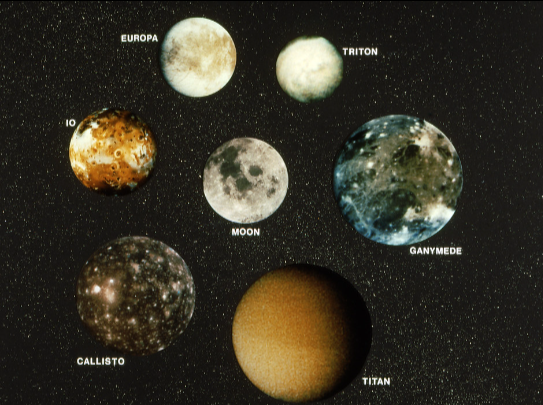
Almost all of the planets in our solar system possess natural satellites. The moon of our own planet, Earth, is a striking yet lifeless celestial body molded by ancient volcanic activity and numerous impact events. While it is the most well-known, it may not be the most captivating. The giant planets in the outer reaches of our solar system each have an extensive group of moons, some of which originated from the same icy substances as their host planets. Despite their considerable distance from the sun and their scarcity of solar energy, these moons exhibit a diversity rivaling that of the planets they orbit.
In this exploration, we embark on a journey to witness some of the most peculiar and captivating celestial bodies. For instance, Jupiter's Callisto and Saturn's Mimas have endured eons of deep freeze, yet they bear remarkable scars from cosmic impacts. Others, like Saturn's shepherd moons Pan and Atlas, as well as Neptune's solitary Nereid, have experienced a dynamic history shaped by interactions with neighboring moons.
What's particularly thrilling is that certain of these extraordinary worlds have been heated by formidable tidal forces from their parent planets, leading to phases of intense activity akin to the processes that shaped Miranda, Uranus' unique moon. In some instances, these forces continue to sculpt these enthralling bodies, giving rise to phenomena like Jupiter's tumultuous Io and Saturn's frigid Enceladus. Beneath its calm exterior, Enceladus might even hold the solar system's most profound secret: the potential for extraterrestrial life.
Strangest Moon In Our Solar System
- Enceladus
- Callisto
- Dactly
- Lapetus
- Nereid
- Lo
- Hyperion
- Titan
- Miranda
- Mimas
1. Enceladus
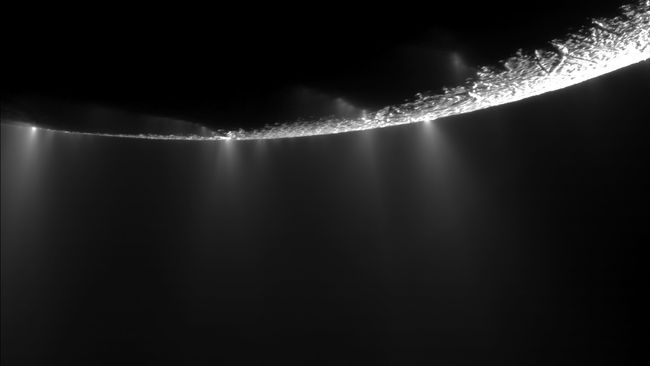
Enceladus has emerged as a focal point of intense scrutiny and debate within the solar system. Its newfound prominence stems from the revelation of substantial plumes of water ice erupting into space from fissures in its southern hemisphere, indicating the likely presence of liquid water just beneath its thin, icy surface.
The peculiar behavior of Enceladus had already raised suspicions prior to Cassini's arrival, owing to earlier images depicting an unusually bright surface and craters that resembled they were dusted with snow. However, the discovery of the ice plumes, initially encountered when Cassini traversed one directly, provided a spectacular confirmation of Enceladus' active nature.
READ ALSO » The Hottest Planets In Our Solar System
Measuring 313 miles (504 km) in diameter and composed of rock and ice, Enceladus should have solidified billions of years ago, aligning with the fate of many of its counterparts in the Saturnian system. Yet, the moon's interior remains warm and dynamic, thanks to tidal forces generated by the gravitational interplay between Saturn and its larger moon, Dione. This unique trait makes Enceladus a pivotal target in the quest for potential life within our solar system.
2. Callisto

Callisto ranks as the third-largest moon in our solar system, closely approaching the size of Mercury. Its primary claim to distinction lies in being the most heavily cratered celestial body within the solar system. Its dusky exterior is adorned with craters extending to the limits of visibility. Among these, the deepest craters have unveiled fresh ice from beneath and dispersed luminous 'ejecta' fragments across the surface.
This cratered terrain owes its existence to Callisto's position within the Jupiter system. The immense gravitational pull of the giant planet disrupts the trajectories of passing comets, often directing them towards their demise. This was vividly demonstrated in the dramatic impact of Comet Shoemaker-Levy 9 in 1994.
While Jupiter's larger moons are more directly exposed to such impacts, absorbing a greater share of them, Callisto's closer neighbors, influenced by stronger tidal forces, have undergone geological processes that erased a significant portion of their ancient craters. In stark contrast, Callisto's surface has preserved its essentially unaltered state for over 4.5 billion years, resulting in a densely cratered landscape that has evolved over countless eons.
3. Dactly
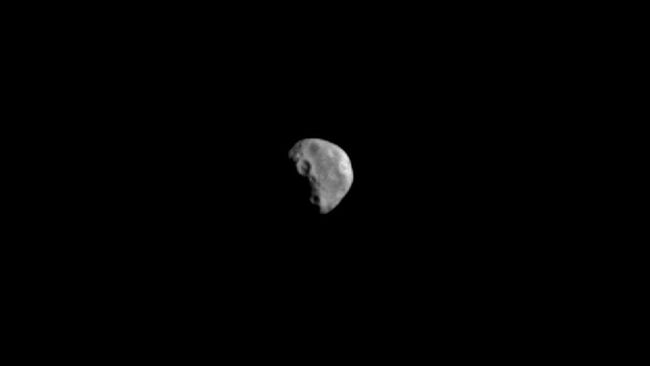
It's doubtful that Dactyl was captured into orbit, and the idea that Ida and Dactyl originated together brings forth its own set of inquiries.
Ida is a prominent member of the Koronis family, which consists of over 300 asteroids sharing similar orbits. This family is believed to have formed approximately 1 to 2 billion years ago due to an asteroid collision. Dactyl could potentially be a smaller fragment resulting from the aftermath of this collision, which eventually found itself in orbit around Ida. However, there's a complication computer simulations indicate that Dactyl would likely be obliterated by an impact from another asteroid.
An alternative hypothesis proposes that Dactyl experienced a disruptive impact but managed to reassemble itself within its orbit.
4. Lapetus
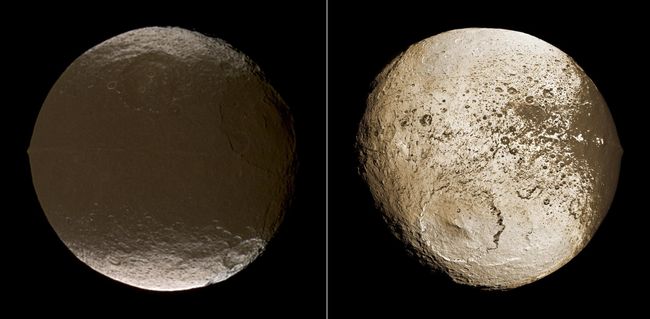
READ ALSO » 5 Fastest Planets In Our Solar System
Lapetus boasts two peculiar features that distinguish it as an eccentric moon. The first anomaly, noted since its discovery in 1671, is its significant variation in brightness between different sides of its orbit. The leading hemisphere, facing forward in its orbit around Saturn, presents a dark brown hue, in stark contrast to the light gray of its trailing side. Initially, a hypothesis proposed that the leading side accumulated dust from minuscule meteorite impacts on smaller outer moons, which then spiraled towards Saturn.
Additionally, Iapetus is encircled by a towering equatorial ridge, measuring 8 miles (13 km) in height and 12 miles (20 km) in width. This distinct feature gives the moon its characteristic walnut shape. The origins of this ridge remain a subject of intrigue. Some theories posit it as a remnant from a period when Iapetus spun much faster and bulged at its equator, while others suggest it could be remnants from a collapsed ring system that once encircled the moon.
5. Nereid
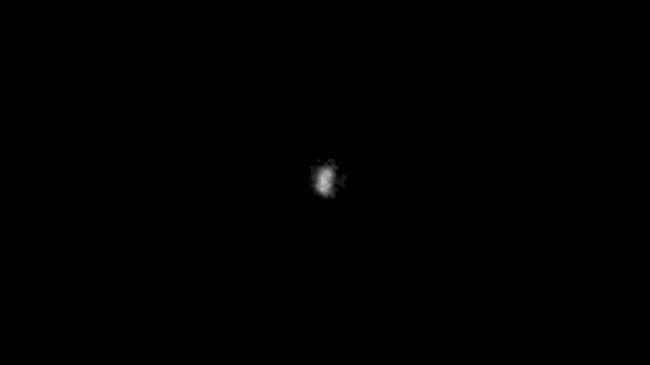
Nereid, Neptune's second moon to be discovered, stands out for its extraordinarily distant orbit. It spans a distance from Neptune that oscillates between 870,000 and 6 million miles (1.4 million and 9.7 million km). Such an orbit is typically associated with captured satellites—objects like asteroids and comets that are drawn into highly eccentric orbits by the gravitational pull of the giant outer planets. However, Nereid's considerable size hints at a more intriguing narrative.
Evidence gathered from Voyager 2's flyby in 1989 suggests that Triton was captured into orbit from the nearby Kuiper Belt. This event would have perturbed the orbits of Neptune's original moons, resulting in the ejection of many of them. Nevertheless, a significant number of astronomers speculate that Nereid may have managed to endure, holding its position at the outer limits of Neptune's gravitational domain.
6. Lo

Io, the closest among Jupiter's four colossal Galilean moons, stands in stark contrast to its outer counterparts. While the others appear tranquil, frozen worlds of rock and ice, Io's terrain bursts forth in a vivid palette of yellows, reds, and browns, adorned with peculiar and ever-shifting mineral formations spawned by the surges of sulfur that coat its surface. In fact, Io reigns as the most volcanically active body in the entire solar system. Although the eccentricities of Io's surface were initially noted during the Pioneer space probe flybys in the early 1970s, its volcanic character was only anticipated shortly before the arrival of the Voyager 1 mission in 1979.
Caught in a gravitational tussle between its outer celestial companions and the formidable Jupiter itself, Io's orbit remains in a state of perpetual flux, defying a perfect circular shape. Even minute alterations in Io's proximity to Jupiter, amounting to less than a 0.5% deviation in its orbit, unleash monumental tidal forces that assail the moon's interior from all directions. As rocks grate against one another, the resulting friction generates intense heat, sustaining the moon's core in a molten state and engendering vast subterranean reservoirs of magma.
7. Hyperion
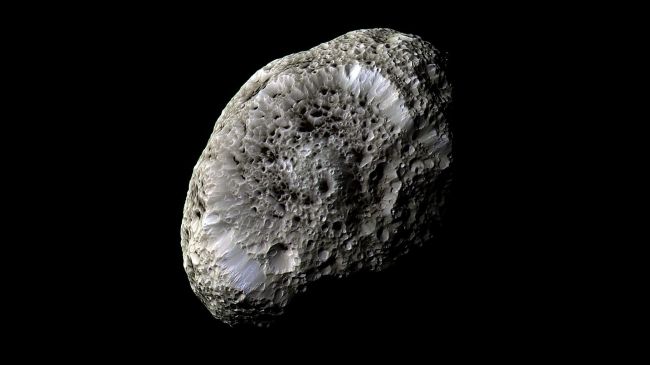
Hyperion stands as the most peculiar-looking moon in the entire solar system, presenting a surface akin to a sponge or coral, adorned with deep, shadowy pits bordered by sharp-edged ridges of brighter rock and ice. Yet, its eccentricities don't end there. Hyperion holds the distinction of being the first non-spherical moon to be discovered and boasts an orbit with a distinctive irregularity.
In a departure from the norm, Hyperion doesn't synchronize its rotation with its orbital period. Instead, it engages in a disorderly dance, its axis of rotation swaying in an unpredictable manner. While, like many moons in the outer solar system, it primarily consists of water ice, its surface exhibits an unusual darkness. When Cassini conducted a close flyby, it gauged Hyperion's density to be a mere 55% that of water, revealing that its interior is largely hollow.
8. Titan

READ ALSO » Top 12 Men Who Have Walked On The Moon
Titan's atmosphere is primarily composed of nitrogen, a gas inert in nature, which parallels Earth's own air composition. However, its distinctive hue, dense haze, and cloud cover arise from a relatively small percentage of methane. Intriguingly, Titan provides an environment where methane effortlessly transitions between its gaseous, liquid, and solid states, mirroring Earth's water cycle that profoundly influences climate patterns. In colder conditions, methane solidifies on the surface as frost and ice. Within milder temperatures, it condenses into liquid droplets, descending as rain that reshapes and softens the terrain before collecting in lakes. In warmer regions, it vaporizes and returns to the atmosphere.
Titan undergoes seasonal changes akin to those on our planet, though its year spans 29.5 Earth years. The winter pole experiences conditions conducive to rainfall, leading to the migration of lakes from one pole to the opposite over each Titanian year. With this dynamic activity, Titan emerges as an alluring target in the quest for extraterrestrial life. Nonetheless, many biologists find it challenging to envisage organisms capable of thriving in such demanding and chemically constrained environments. As a result, a consensus prevails that Titan's nearby neighbor, Enceladus, with its watery interior, holds more promising potential for harboring life.
9. Miranda
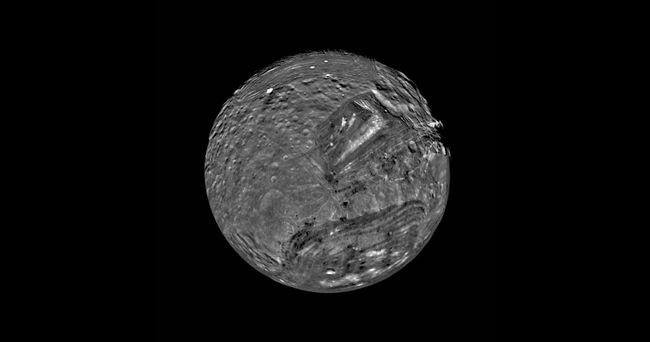
Miranda stands out as one of the solar system's most peculiar worlds, as evidenced by Voyager images that unveil a mosaic of terrains, seemingly arranged in a haphazard manner. Some regions exhibit significant cratering, while others show fewer impact marks a sign of their relative youth, having endured less cosmic bombardment. Notable features include concentric ovals resembling a race track and parallel V-shaped formations creating a chevron-like scar.
Initially, a theory posited that Miranda might be a composite world, forged from fragments of a prior moon that gathered in orbit around Uranus. Astronomers contemplated whether this precursor moon met its demise in a colossal interplanetary collision and whether this cataclysmic event might somehow connect to Uranus' notably skewed tilt. Yet, subsequent research has found this theory inadequate in explaining Miranda's diverse surface features, deeming the likelihood of such an impact to be low. Instead, it seems plausible that tidal forces bear responsibility.
Currently, Miranda traces an orbit close to circular. However, in the past, its orbit held a 'resonant' relationship with the larger moon, Umbriel. This alignment brought the two moons into frequent positions that elongated Miranda's orbit into an extreme ellipse, subjecting it to intense tidal forces. Pushed, pulled, and internally heated, its surface fractured and rearranged before the moons shifted positions once more, leading to a decline in Miranda's activity.
10. Mimas
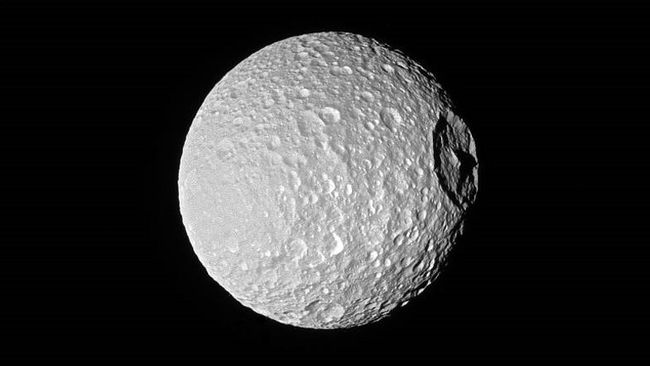
Mimas holds the position as Saturn's closest substantial moon, orbiting within the space between Enceladus and the smaller moons Pan and Atlas. Despite its modest diameter of only 246 miles (396 km), Mimas stands as the smallest known object in the solar system to have assumed a spherical shape through its own gravitational pull. Notably, some larger celestial bodies have not achieved this feat, leading most astronomers to conclude that Mimas' low density, just 15% greater than that of water, is the crucial factor enabling this spherical formation.
